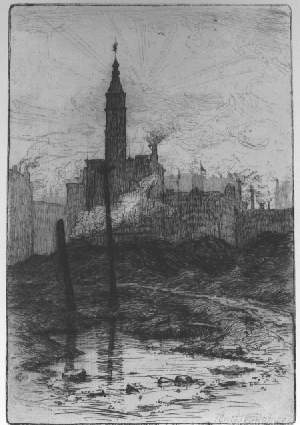Bertha E. Jaques
Today, we finally get around to honoring greatness. The University of Houston's College of Engineering presents this series about the machines that make our civilization run, and the people whose ingenuity created them.
Here's a fine photo. It's a woman -- maybe in her 50s -- with iron-gray hair and no makeup. Clear, steady eyes and strong features. She's Bertha Jaques -- born in 1863 and died in 1941.
On the surface of things, she lived an ordinary enough life. She was married to a Chicago surgeon. She liked to paint. Then, when she was thirty, something happened. She saw an exhibition of the new French etchings at the Chicago Columbian Exposition.
It was an important moment. Jaques went home to try this new medium. She bought a copper plate at the hardware store. She found wax, pitch, and nitric acid. She wrapped a paint roller with leather and located an old dentist's drill.
She was transfixed as the nitric acid carved out her first picture. She let it destroy the image completely. But her learning curve was fast. Her second etching is on museum display today. She improvised, failed, and succeeded. Her husband helped her fashion etching equipment from surgical tools.
She got a press from Milwaukee. Then, in 1897, she gave us the first etchings in the Midwest. She eventually left over 400 prints. And they occupy a peculiar place in American art.
The prints are lovely -- really lovely. Most are scenes -- locations. They are places in reality, but they're also places in her mind. They romanticize reality, yet they show an almost classic order and discipline. Jaques makes powerful use of perspective. She wields space with an engineer's eye.
We see her genius as she rapidly creates a new control of texture. We trace the etchings chronologically. Here's where she learned to capture industrial steam and smoke with a scratching needle. There she's caught the reflection of moonlight off water.
All the while, in outward shape and form, she was the typical turn-of-the-century upper-middle-class wife. Never mind that she founded and ran the Chicago Society of Etchers. Never mind that she mentored the whole field of etching in America.
Only today do artists see her work for its pioneering artistic and technical genius. I personally tire of success stories -- of people honored in their time. The more I look at the things we make and do, the surer I am that real greatness rises slowly, like cream in milk -- the way Bertha Jaques did in the arena of American art.
I'm John Lienhard, at the University of Houston, where we're interested in the way inventive minds work.
(Theme music)
I've used exhibition catalog material for background on Bertha Jaques (nee Clausen). e.g.: de Vecsey, Esther, Bertha E. Jaques (1863-1941): An American Printmaker -- A Retrospective, April-May 1982. (This was an exhibit catalog for an earlier exhibit at the Gerhard Wurzer Gallery in Houston. The dates of a second exhibition at the Gallery are May 17 through June 30, 1991.)

Image courtesy of Carol Lienhard
Lake Front by Bertha Jaques, 1905